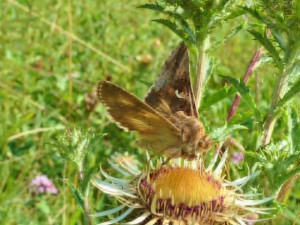In this post Carsten Brühl shares some information on moths, pollination and their potential role in current pollinator risk assessment approaches.

The Silver Y (Autographa gamma) is one of the rarer diurnal moths that can be observed in the agricultural landscape visiting many different flowers (photo by C. Brühl).
Pollination is a crucial plant–animal interaction in ecosystems, and moths (Lepidoptera) are a widespread and species-rich group of flower visitors. Since the risk of pesticides towards pollinators should be addressed it would make sense to not only include the honey bee or other wild bees in such an approach. Of the described 180,000 lepidoptera species described, only 10% are butterflies, the bulk of 90% of the species belongs to moths. In our review we analysed the literature, and extracted information on the relevance of moth pollination in various ecosystems, including agroecosystems, particularly for Europe and North America.
Overall, 227 moth–flower pollination interactions were found, including certain specialized relationships between plants and pollinating seed predators. Limited information is available on the role of moth pollination in natural ecosystems. In temperate agro-ecosystems, moths are most likely not essential to crop pollination, however they contribute to the pollination of non-crop plants, which are crucial for maintaining biodiversity in these ecosystems. With biodiversity as an identified protection goal in the risk assessment for pesticide registration moths might be a group that deservers further attention.
In general, the role of moths as pollinators appears to be underestimated because only a few studies on moth pollination are available, and long-term, ecosystem-scale research is necessary to address temporal fluctuations in their abundance and community composition.
The paper was authored by Melanie Hahn & Carsten Brühl and published open access in Arthropod-Plant Interactions.
